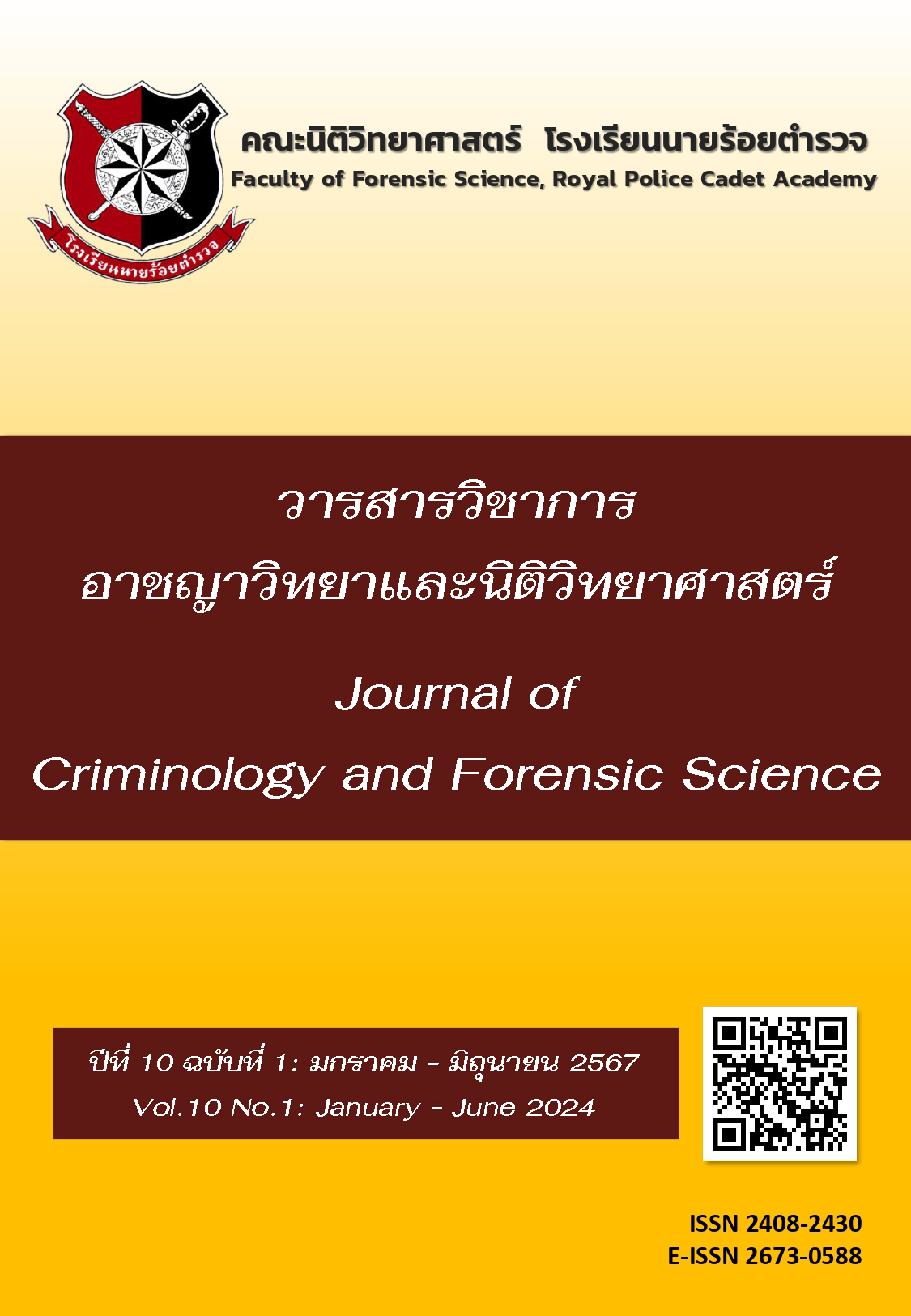การประยุกต์ใช้นิติกีฏวิทยาประมาณค่าช่วงเวลาหลังเสียชีวิต
Main Article Content
บทคัดย่อ
แมลงมีบทบาทสำคัญในการสืบสวนการเสียชีวิตที่ผิดธรรมชาติ งานวิจัยนี้ต้องการแสดงการใช้ประโยชน์จากการศึกษาวงจรชีวิต พฤติกรรม และถิ่นที่อยู่อาศัยของแมลง เพื่อนำมาประยุกต์ใช้ในทางนิติวิทยาศาสตร์ คือการประมาณระยะเวลาหลังการเสียชีวิต (Post-Mortem Interval, PMI) การทำงานด้านนิติกีฏวิทยาเป็นการปฏิบัติตามพระราชบัญญัติการให้บริการด้านนิติวิทยาศาสตร์ พ.ศ.2559 การทดลองนี้เป็นการแสดงการตรวจสอบหนอนและดักแด้ที่พบบนร่างศพในที่เกิดเหตุ จังหวัดปัตตานี ภาคใต้ของประเทศไทย โดยการเก็บตัวอย่างหนอนและดักแด้ ผู้เขียนเก็บรักษาตัวอย่างด้วยเอทิลแอลกอฮอล์ 80% พร้อมติดฉลากรายละเอียด และนำหนอนและดักแด้อีกส่วนหนึ่งไว้ในภาชนะเพื่อให้อาหารจนโตเป็นตัวเต็มวัย หลังจากนั้นจึงทำการ identify โดยวิธีการ section ตัดส่วนปลายของหนอนด้านป้าน ที่เรียกว่า spiracle และตรวจด้วยกล้องจุลทรรศน์ (microscopic examination) ส่วนดักแด้ทำการตรวจด้วย X-Ray Computerized Tomography Scan (micro-CT scan) พบหนอนแมลงวันหัวเขียววัยที่ 2 และ 3 ปรากฏอยู่ ดังนั้น การประเมินระยะเวลาภายหลังการเสียชีวิตของเคสนี้จึงไม่ต่ำกว่า 30 วัน ข้อมูลนี้มีความสำคัญสำหรับการสืบสวนการตายเนื่องจากช่วยในการกำหนดช่วงเวลาหลังการชันสูตรศพขั้นต่ำ (PMI ขั้นต่ำ) ควบคู่กับการศึกษาการย่อยสลายของศพ
Article Details

อนุญาตภายใต้เงื่อนไข Creative Commons Attribution-NonCommercial-NoDerivatives 4.0 International License.
เนื้อหาและข้อมูลในบทความที่ลงตีพิมพ์ใน วารสารวิชาการอาชญาวิทยาและนิติวิทยาศาสตร์ โรงเรียนนายร้อยตำรวจ ถิอว่าเป็นข้อคิดเห็นและความรั้บผิดชอบของผู้เขียนบทความโดยตรงซึ่งกองบรรณาธิการวารสาร ไม่จำเป็นต้องเห็นด้วยหรือรับผิดชอบใดๆ
บทความ ข้อมูล เนื้อหา รูปภาพ ฯลฯ ที่ได้รับการตีพิมพ์ใน วารสารวิชาการอาชญาวิทยาและนิติวิทยาศาสตร์ ถือว่าเป็นลิขสิทธิ์ของวารสาร วารสารวิชาการอาชญาวิทยาและนิติวิทยาศาสตร์ หากบุคคลหรือหน่วยงานใดต้องการนำทั้งหมดหรือส่วนหนึ่งส่วนใดไปเผยแพร่ต่อหรือเพื่อกระทำการใดๆ จะต้องได้รับอนุญาตเป็นลายลักษณ์อักษรจาก วารสารวิชาการอาชญาวิทยาและนิติวิทยาศาสตร์ ก่อนเท่านั้น
เอกสารอ้างอิง
Aballay, F. H., Domínguez, M. C., & Fernández Campón, F. (2012). Adult fanniidae associated to pig carcasses during the winter season in a semiarid environment: Initial examination of their potential as complementary PMI indicators. Forensic Science International, 219(1), 284.e1-284.e4. doi: 10.1016/j.forsciint.2011.11. 019.
Adams Z. J. O. and Hall M. J. R. (2003). Methods used for the killing and preservation of blowfly larvae and their effect on post-mortem length. Forensic Science International. 138(1-3), 50-61. doi: 10.1016/j.forsciint.2003.08.010.
Alba-Tercedor, J. (2014). From the sample preparation to the volume rendering images of small animals : A step by step example of a procedure to carry out the micro-CT study of the leafhopper insect Homalodisca vitripennis (Hemiptera : Cicadellidae). Bruker Micro-CT Users Meeting, 2014, 260–288.
Alba-Tercedor, J. (2016). Microtomographic study on the anatomy of adult male eyes of two mayfly species. Zoosymposia 11: 101–120.
Byrd J. H. and Tomberlin J. K. (2020). Forensic Entomology: The Utility of Arthropods in Legal Investigations. 3rd Ed. European Journal of Entomology 117(1). DOI:10.14411/eje.2020.014.
Davies L. and Ratcliffe G. G. (1994). Development rates of some pre-adult stages in blowflies with reference to low temperatures. Medical and Veterinary Entomology, 8(3), 245–254. doi: 10.1111/j.1365-2915.1994. tb00506.x.
Davis J. B. and Goff M. L. (2000). Decomposition patterns in terrestrial and intertidal habitats on Oahu Island and Coconut Island, Hawaii. Journal of Forensic Sciences, 45(4), 836–842.
Deonier C. C. (1940). Carcass temperatures and their relation to winter blowfly populations and activity in the Southwest. Journal of Economic Entomology, 33(1), 166–170. doi: 10.1093/jee/33.1.166.
Dorothy, E. Gennard. (2007). Forensic Entomology: An Introduction (pp.248). United Kingdom: John Wiley & Sons Ltd.
Forensic Science Services Act 2015 Bhumibol Adulyadej P. R. (2015, 3 August). Royal Gazette (Volume 133, Section 67A, pp. 45-50).
Gemmellaro Denise. (2017). Forensic Entomology: Where Insects Meet the Law.
Entomology today brought to you by the entomological society of America. June
st. https://entomologytoday.org/2017/06/21/forensic-entomology-where-insects-
meet-the-law/#.
Hadley, D. (2019). Learn the 5 Forms of Insect Pupae. https://www.thoughtco.com/insect-pupal-forms-1968485.
Jason, H. Byrd and Jeffery K. Tomberlin. (2020) . Forensic Entomology: The Utility of Arthropods in Legal Investigations 3rd Edition (pp.575). Australia: Taylor & Francis Group, LLC.
Keklikoglou, K., Sarah Fulwetter, Eva Chatzinikolaou, Patricia Wils, Jonathan Brecko, Jiří Kvaček, Brian Metscher and Christos Arvanitidis. (2019). Micro-computed tomography for natural history specimens : a handbook of best practice protocols. European Journal of Taxonomy 522: 1–5. www.europeanjournaloftaxonomy.
Lee, H. L. (1989). Recovery of Forensically Important Entomological Specimens from Human Cadavers in Malaysia – An Update. Malaysia Journal of Pathology, 11, 33-36.
Lee, G. M. and W.D. Lord. (1994). Entomotoxicology: A new area for forensic investigation. American Journal of Forensic Medicine and Pathology, 15(1), 51-57.
Lord, W. D. and J. R. Stevenson. (1986). Directory of Forensic Entomologist, Defense Pest Management Information Analysis Center, Walter Reed Army Medical Center, Washington, D.C., 42 p.
Lee, Goff M. (2000). A Fly for the Prosecution: How Insect Evidence Helps Solve Crimes (pp.240). United States: Harvard University Press.
Matuszewski, S. (2021). Post-mortem interval estimation based on insect evidence Current Challanges. Science & Justice. 12(4), 314. doi: 10.3390/insects1204 0314.
Nelson, Riley C. and Karin Gastreich . (2001). Permanently mounting Insects and other small Arthropods on microscope slides. Retrieved August, 30 2022, from https://biology.byu.edu.
Payne, J. A. (1965). A summer carrion study of the baby pig Sus scrofa Linnaeus. Ecology, 46(5), 592–602.
Pengsakul, Theerakamol, Nantana Sirisup, Panuwat Chutivongse and Padet Siriyasatien. (2008). Journal of Forensic Physician Association of Thailand Volume 2, Number 2, July – December 2008.
Richards, S. Cameron, Thomas J. Simonsen, Richard L. Abel, Martin J.R. Hall, Daniel A. Schwyn and Martina Wicklein . (2012). Virtual forensic entomology : Improving estimates of minimum post-mortem interval with 3D micro-computed tomography. Forensic Science International. Volume 220, Issues 1–3, 10 July 2012, Pages 251-264.
Rowe, Aaron. (2007). Bugs as Evidence. Law and Order, March, 55(3), 55-56.
Russell, W. C. (1947). Biology of the Dermestid Beetle with Reference to Skull Cleaning. Journal of Mammalogy, 28(3), 284-287.
Saigusa, Kiyoshi, Masataka Takamiya, Masatoshi Matsumasa, and Yasuhiro Aoki. (2006). The Forensic Availability of a Simple and Time Saving Method for the Identification of Dipteran Species to Estimate Postmortem Interval Using Entomological Evidence, (Letter to the Editor). Legal Medicine, 8(4), 203-254. doi: 10.1016/j.legalm ed.2006.04.004.
Sharma Ruchi, Rakesh Kumar Garg and J. R. Gaur. (2015). Various methods for the estimation of the post mortem interval from Calliphoridae: A review. Egyptian Journal of Forensic Sciences. 5(1), 1-12. doi:10.1016/j.ejfs.2013.04.002.
Sirisatian Palita, (2022) . A Thesis Submitted in Partial Fulfillment of the Requirements for Master of Science (FORENSIC SCIENCE) Silpakorn University Academic Year 2022 Copyright of Silpakorn University.
STEMpedia. (2022). Prepared Microscope Slides: Insects Specimen. Retrieved Retrieved August, 30 2022, from https://thestempedia.com/tutorials/prepared-microscope-slides-insects-specimen/
Sukontason, Kabkaew L. , K. Sukontason, P. Narongchai, S. Lertthamnongtham, S. Piangjai and J. K. Olson. (2001). Chrysomya rufifacies (Macquart) as a forensically-important fly species in Thailand : A case report. Journal of Vector Ecology. 26(2) : 162-164.
The American Board of Forensic Entomology. (1996). The ABFE is the certifying Board for Forensic Entomologists in North America. Retrieved August, 30 2022, from https://forensicentomologist.org/
Thomas, D. B., and A. C. Chen. (1989). Age Determination in Adult Screw-Worms (Diptera: Calliphoridae) by Pteridine Levels. Journal of Economic Entomology. 82(4), 1140-1144. doi: 10.1093/jee/82.4. 1140.
Universiti Teknologi MARA (UiTM). (2014). "Blowfly maggots provide physical evidence for forensic cases." ScienceDaily. Retrieved August, 30 2022, from www.sciencedaily.com/rel eases/2014/09/140903133125.htm.
Zoonosis. (2015, Oct 31st) http://en.wikipedia.org/wiki/Zoonosis .
Zumpt, F. (1965). Myiasis in Man and Animals in the Old World. United Kingdom: Butterworths.


